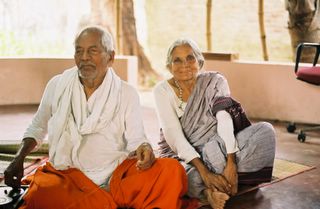Dalits: Struggle and Caste Liberation (D. Willis)
Terminology is of course changing, and Dalit is the word Dalits use for themselves as well as the name most commonly used in Indian society today for those formerly called "untouchables" and, by Mahatma Gandhi, "Harijans" (Children of God). Even Amma, a staunch Gandhian, uses the term Dalits. I have never heard her use the word Harijan. "Dalit" means a scattering or dispersal, but it also implies a liberation from a system. Krishnammal has of course been working closely with Dalits for many years. In many ways, as she will tell you, they are the focus of her efforts.
Ambuselvam tells us that the most important goal in the liberation struggle now is to form an alliance of Dalits, what he calls the "Movement for Integrated Dalit Liberation Rights." There are numerous SC in India, the so-called Scheduled Castes and in India, the term which the government and much of the popular and academic media use for Dalits and which much of the popular and academic media uses as well. SC describes the reservations accorded to government jobs, places in university admissions, and other benefits for Dalits. The number of SC or Dalits in Tamil Nadu alone is 374, when all subcastes and others are included, 110 according to the government which subsumes many categories. So the most urgent need is to unite these various groups against the domination and oppression of other communities as well as historical structural injustice.
The Dalit Resource Center, located at the Tamil Nadu Theological Seminary, where much political activism is taking place, is concerned with learning strategies and legal support as well as cultural activities. They have work in 1700 villages around Madurai. Every year in May they hold a massive arts and music festival with 800 activists that goes on for 24 hours non-stop at TTS. Lots of drumming! The thappu, a large round drum made of cow-skin, is a special symbol of the Dalits and was traditionally used when the village crier, always a Dalit, walked around the village announcing the news. We note, too, a growing concern for gender and women in the Dalit movement in general and certainly in terms of the arts. Women drummers are a new and powerful sight for India. For Ambuselvam, and certainly for Amma, too, the most difficult challenges now are how the Dalits can emerge as a united, large movement.
Perhaps 20-25% of the Indian population is Dalit. If Dalits can overcome their differences (intercaste marriage is still more or less unknown) it will be a force to be reckoned with in Indian society and politics. And two of the most effective groups at the center of this change are Dr. K.S. Krishnasamy and the Pudhia Tamilzakam, the New Tamil Party, and the Dalit Panthers of India (DPI), led by Sri Thirumavalavan (and begun around the same time as the Black Panthers in the United States).
Dalit goals are the annihilation of caste, the promotion of Dalit identity (here, a Tamil nationalist identity), and Dalit integration, as Ambuselvam tells us. Echoing sentiments like those of the DPI, Ambuselvam says, very emphatically, "Dalits are not Hindu! We are Dalits. We have our own religion, our own community."
Thursday is a day of transition, preparing for the journey to Kuthur and LAFTI. I am asked to give a talk on ethnography in India to a group of American college students doing homestays with Indian families. We talk for two hours about caste and many other issues, a primary concern of theirs being gender roles, which are rapidly changing in India. They are a bright and curious group.
Sekar and I head to the northeast bus stand around three, beginning a six-hour journey through the traditional ancient districts of Madurai and Pudukottai to the heartland of Tamil Nadu in the Cauvery River Delta around Tanjore (Thanjavur) and then the coastal district of Nagappatinam where LAFTI is located.
Nagappatinam, mentioned in many ancient chronicles from around Asia, is the fountain-head of a great cultural transmission, one that would forever change the societies of Southeast and East Asia. It is from here, where Amma and Appa have located themselves, too, that so much of the culture and religion, especially Buddhism and Hinduism, as well as the social tructures, social values, and political statecraft of India flowed freely to Indonesia, Malaysia, Cambodia, Thailand, Vietnam, the Philippines, China, Korea, and Japan.


0 Comments:
Post a Comment
<< Home